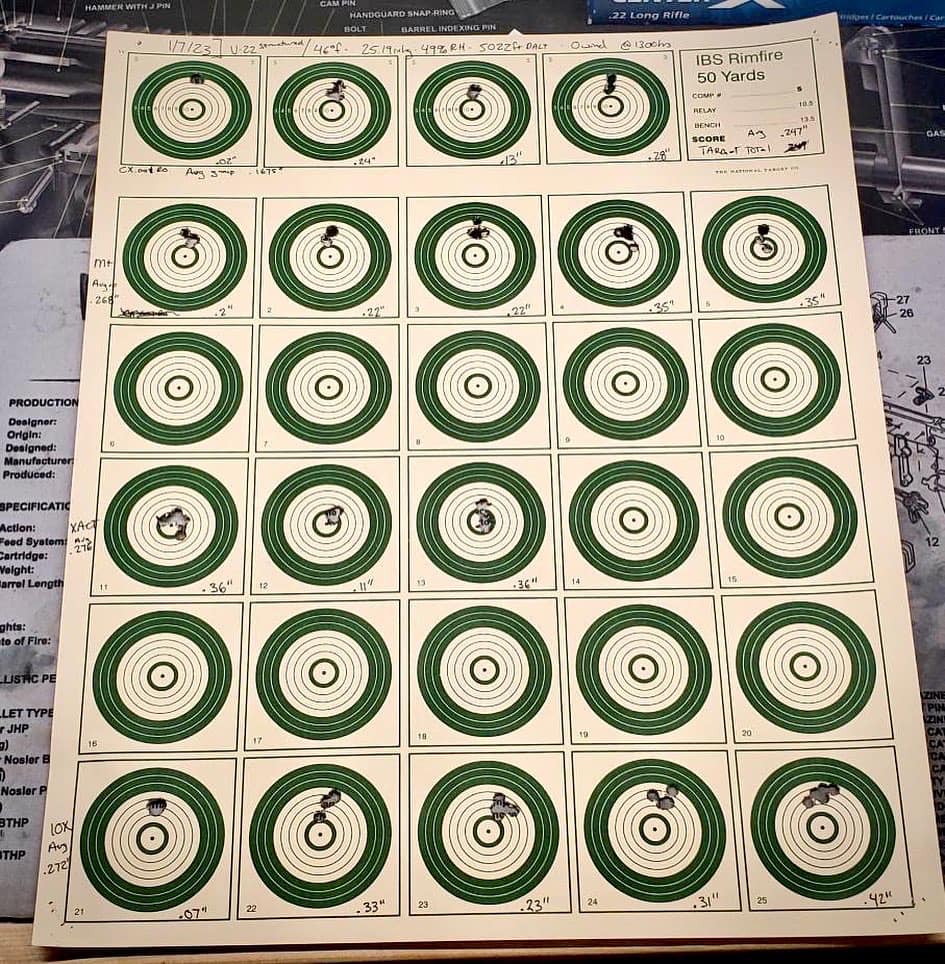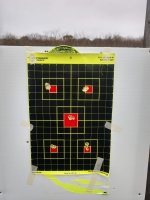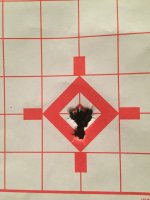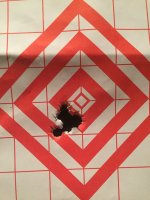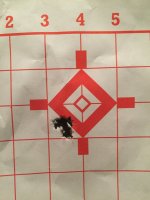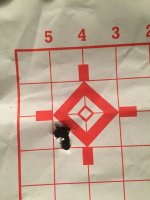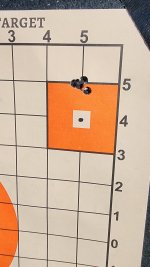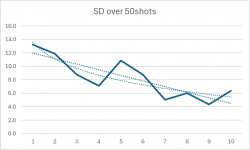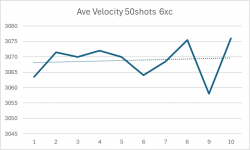Hi Chris,
An on line interview. Subjectively objective anecdotes. SOA.
1) How many rounds on the current barrel?
840 rounds
2) Still a true one hole gun?
yes … but, more importantly it hasn’t changed in the life of the barrel. Clean cold bore … or cold bore. Zero group size is very good.
3) Fire cracking description?
I have documented this from the beginning. I use a borescope for a number of reasons. At 840 rounds … I have fire cracking 4” into the bore. To be fair, I am not a speed junky. Accuracy first … speed second.
The throat is in amazingly good condition. I will be happy to scope/video the barrel for all to see.
I have never done ladder tests with any of my competition rifles. ALL tuning has been accomplished at 100 yards. I use plumb lines drawn onto target noting/following center of bore in relation to poi. I work to achieve consistent pressure loads through seating depth as a final determinant.
6) What do you mean a node in a node?
I have found that I could take the caliber/barrel another step. I tune a rifle much like many making small incremental changes … isolating one variable at a time. Before I compete with a new barrel/tune …. It has to repeat, in testing, three consecutive range trips. Think 6 dasher ES and that is what I experience with my ELR rifle (3-4 ES).
7) Are you aware of other Structured Barrels acting the same?
Yes, Chase Stoud is a highly competent shooter who uses a structured barrel. Plus, we have sent several barrels to Europe (my reamer/my 416 design) with same level performance.
8) "No Vertical"- in the ELR world what is that?
Lack of vertical at distance is the holy grail of success for any ELR shooter. The “room for error” is very small when distance is added to the equation. If vertical’s are introduced into the system….. the shooter/spotter end up chasing their previous shot.
9) How important to control that?
Controlling verticals is a variable we all work to eliminate. If barrel temp increases rapidly in a 10-15 shot string, and with time restrictions …. It’s easy to experience a “high/low” situation. It’s not uncommon to fire three -five rounds in a minute to a minute and a half. At distance … when a shooter has a hit; the follow up shot is typically immediately after an impact report from scoring. Remember … we are using 185+ grains of powder … a lot of heat is produced. Controlling the heat is one variable that equates to success at distance.
10) You have shot a few of our guns- Do they all have unique recoil in your experience?
Yes, it’s unique and I find it very difficult to explain. That’s why I enjoy watching others drive the 416. There are a number of videos out where it appears to not even move me. My follow up shot is typically moving the rifle forward just a bit meaning reticle is above target after recoil impulse.
11) I use the term "quiet" to describe the recoil: Is that a fair statement?
Again, it’s unique and I have a difficult time explaining. Sure, the combination of the barrel, weight, recoil lug placement, muzzle brake are all contributing; but, it’s a very soft recoil impulse. To give an idea … it’s a Sunday drive in your grandmothers caddy. It’s surprisingly very very smooth.
12) Our AR... was it unique?
Even more so than my bolt gun. The difference is more drastic given all the moving parts compared to a bedded bolt gun.
13) You have 800+ rounds on the barrel: How many have been tracked and recorded?
Probably the number one question I receive ….. hey Chris what do you right down in your book. It is always with me. I track round counts, barrel conditions, clean/dirty conditions … temps, locations, target packages … atmospherics.
14) On a scale of 1-10 (10 high): Do you consider yourself detail oriented?
10. Wife calls me anal. I feel it has been one reason for consistency over the years with varying calibers. Patterns exist in our sport … identifying those patterns adds to consistency.
15) Is Mirage a reduced event?
Mirage is reduced from the scope objective to the muzzle. Mirage exists in space beyond, but having a clearer sight picture is a welcome feature. ELR … mirage and the ability to perform in heavy mirage conditions divides the competition field quickly.
16) You had a side by side event on the island: two .416's were present. What was the differences between the two guns?
Yes …. On an island shooting over salt water to targets staked above water line. Big difference, again, is heat in the barrel. Two rifles … my reamer, my design …. Structured barrel retained less heat than standard barrel. Again …. It’s all about verticals and heat can/will introduce verticals.
17) Did they shoot the same? all aspects.
Both rifles uses an exact tune … same bullet… same powder. Same everything other than one was in a chassis. My rifle is in a bedded McMillan beast Gen 2 stock. John… strings of fire introduce building heat in barrels. I see less verticals because of the slowing heat build up.
18) As I recall- one of the shooters then bought two 22cal barrels to test on their platform. Chris Baxter groups shown earlier. What do you think of the results of the 22cal groups?
22LR ammo is so specific to a particular rifle. A structured barrel and a wide variety of ammo is an ideal proving ground for the barrel.
Most important question: You have a unique "in your face" military background. If you were to be in an engagement and you are on an over-watch team or sniper team:
Scale of 1-10 (10 high) our barrel on the gun or standard barrel?
I’ve mentioned this to John before … if my life depended on it … I would want my structured barrel with me. It is a confidence value that I would want. I’ve spent a lot of time behind one of your barrels … it’s a variable that is consistent; one that I’m confident with.
The military side and civilian side couldn’t be any more different other than reading wind, fundamentals and spotter/shooter communication. Equipment, specs, ammo (in some cases), objective(s), weight couldn’t be more different.
Reducing verticals in the total solution remains a common factor.
Same question comparing a standard barrel to ours: What is the scale 1-10 (10 high) that you would choose a standard barrel over ours?
I will choose to use a structured barrel everyday that ends In “y”. I’ve used and had success with a number of good Bartlein barrels. Until very recently, I would ONLY use a Bartlein barrel as a foundation for a structured barrel. The host manufacturer is important … I see a structured barrel as a “next level” … adder if you choose. My sport is basically F1 compared to nascar or dirt track type racing. I’m looking for that “better” performance in my 416 system.
I will be using a K&S host barrel for the structuring John performs at his site. All my barrels are gain twist - right hand twist - 40” finished.
A lot of good barrel manufacturers out there … I simply want that next level … next level gear of performance.
BIG NOTE: When we say standard barrel- there is absolutely no derogatory intent. Without a great barrel we are a waste of time. We just try to take the great barrel to greater extended capabilities..
Please feel free to contact me directly with any questions. I want others to enjoy the sport I so dearly appreciate. Best of luck.
Cheers!
Chris Schmidt
Tennesseee

